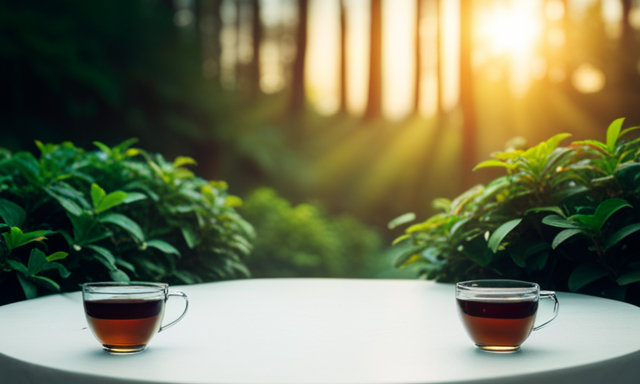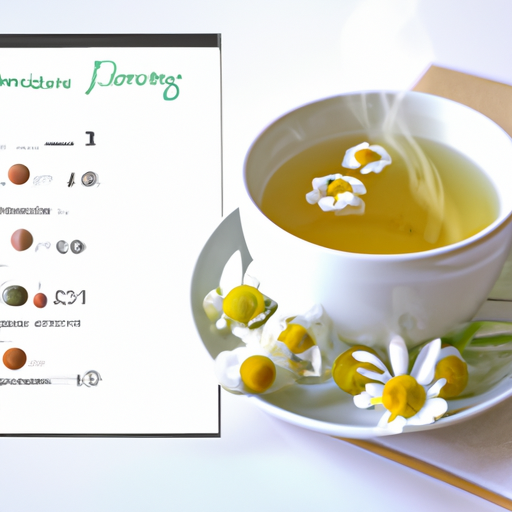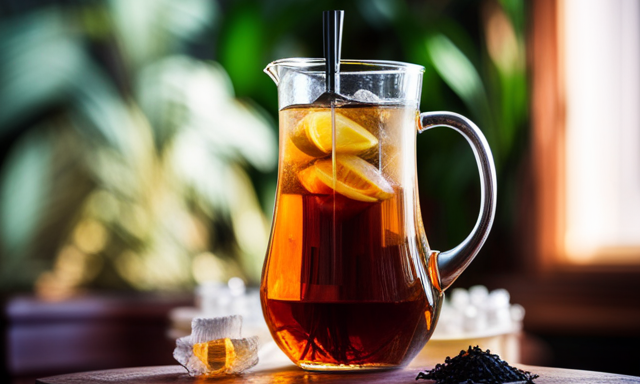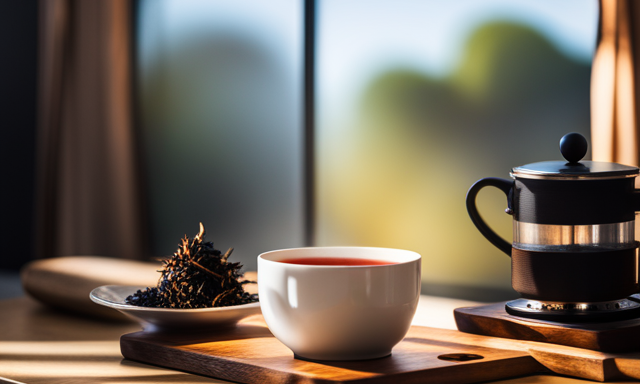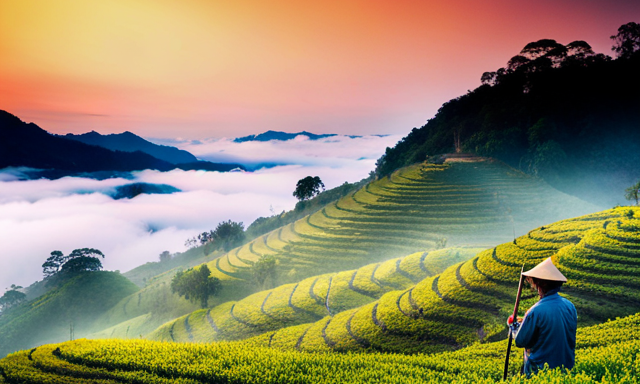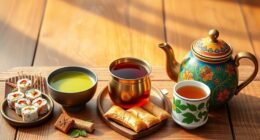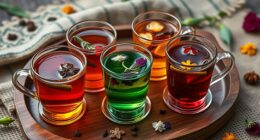When it comes to tea, there are numerous choices available. However, the rivalry between oolong and green tea is a long-standing one. These two influential teas have been competing for the title of the healthiest brew, and now, we will determine the winner.
Get ready to dive into the origins, nutritional benefits, and taste profiles of oolong and green tea. We’ll also explore which one reigns supreme when it comes to weight loss and detox.
But hold on, we won’t stop there. We’ll also discuss any potential side effects and environmental impact. By the time we’re done, you’ll have all the evidence you need to make an informed decision on which tea is truly the healthier option.
So grab your teacup and get ready, because we’re about to embark on the ultimate tea showdown.
Key Takeaways
- Both oolong and green tea are rich in antioxidants and offer significant health benefits.
- Oolong tea has less caffeine than green tea, making it a better choice for those sensitive to caffeine.
- Oolong and green tea contain vitamins and minerals that support immune function and overall health.
- Sustainable farming practices can minimize the environmental impact of oolong and green tea production.
The Origins and Processing Methods of Oolong and Green Tea
The origins and processing methods of oolong and green tea differ, highlighting the unique characteristics and flavors each tea possesses.
Oolong tea is primarily grown in China and Taiwan, while green tea is cultivated in various countries, including China, Japan, and India.
Oolong tea is partially fermented, which gives it a complex and rich flavor profile, ranging from floral to fruity notes. On the other hand, green tea is unfermented, preserving its natural antioxidants and resulting in a more grassy and vegetal taste.
The processing methods also vary, with oolong tea undergoing withering, oxidation, and firing, while green tea is steamed or pan-fried to halt oxidation.
Understanding the origins and processing methods of these teas sheds light on their distinct characteristics and sets the stage for a nutritional comparison between oolong and green tea.
Nutritional Comparison between Oolong and Green Tea
When comparing the nutritional content of oolong and green tea, several key points come to mind.
Firstly, both teas are rich in antioxidants, which are known to protect the body from harmful free radicals.
Secondly, the caffeine levels in oolong and green tea differ, with oolong tea containing less caffeine than green tea.
Lastly, both teas contain vitamins and minerals that contribute to overall health and well-being.
Antioxidant Content
Imagine sipping on a warm cup of tea and feeling the invigorating burst of antioxidants that oolong and green tea provide, but do you know which one packs a more powerful punch? Antioxidants play a crucial role in disease prevention, and both oolong and green tea are rich in these beneficial compounds. Let’s take a look at the antioxidant content of these teas in the table below:
| Tea Type | Antioxidant Content |
|---|---|
| Oolong | High |
| Green Tea | High |
As you can see, both oolong and green tea offer a significant amount of antioxidants, making them valuable additions to a healthy diet. Now, let’s explore another important aspect of these teas: their caffeine levels.
Caffeine Levels
Not only do oolong and green tea offer an abundance of antioxidants, but they also have varying levels of caffeine. When comparing the caffeine content, it’s important to note that oolong tea generally contains less caffeine than green tea. On average, a cup of oolong tea contains about 30-50 milligrams of caffeine, while a cup of green tea contains about 20-40 milligrams.
These differences in caffeine levels may have implications for individuals sensitive to caffeine or those looking to limit their intake. Additionally, it’s worth mentioning that caffeine can affect sleep patterns, with higher intake potentially leading to difficulty falling asleep or staying asleep.
Transitioning into the subsequent section about vitamins and minerals, it’s important to consider the overall nutritional value of oolong and green tea.
Vitamins and Minerals
Boost your health with the vitamins and minerals found in both oolong and green tea. Both types of tea contain beneficial vitamins such as vitamin C, vitamin E, and vitamin K. These vitamins play important roles in supporting immune function, promoting healthy skin, and aiding in blood clotting.
Additionally, oolong and green tea are rich in minerals like potassium, calcium, and magnesium. These minerals are essential for maintaining proper nerve function, regulating blood pressure, and supporting strong bones.
Adding oolong or green tea to your daily routine can provide you with a natural source of these important vitamins and minerals.
Moving forward, let’s explore the specific health benefits of oolong tea.
Health Benefits of Oolong Tea
Did you know that drinking oolong tea can improve your overall health and well-being? Oolong tea is packed with numerous health benefits that can positively impact your body and mind.
One of the most well-known benefits of oolong tea is its potential for weight loss. Studies have shown that oolong tea can help increase metabolism and fat oxidation, making it an excellent addition to a weight loss regimen.
Additionally, oolong tea contains antioxidants that can reduce inflammation and lower the risk of chronic diseases such as heart disease and diabetes. It also promotes healthy digestion, boosts brain function, and strengthens the immune system.
As we transition to discussing the health benefits of green tea, it is important to note that both oolong and green tea offer incredible advantages, so let’s explore what green tea has to offer.
Health Benefits of Green Tea
Are you ready to discover the amazing health benefits that green tea can offer you? Here are four reasons why green tea is good for your health:
-
Green tea and heart health: Studies have shown that regularly consuming green tea can help lower the risk of heart disease. The antioxidants in green tea, such as catechins, help reduce inflammation and improve blood flow.
-
Green tea and cancer prevention: Green tea contains compounds called polyphenols, which have been found to have anti-cancer properties. These polyphenols help inhibit the growth of cancer cells and protect against DNA damage.
-
Weight management: Green tea has been shown to help with weight loss and weight maintenance. It can boost metabolism and increase fat oxidation, helping you burn calories more effectively.
-
Mental health benefits: Green tea contains an amino acid called L-theanine, which has been found to promote relaxation and reduce stress levels.
Now, let’s explore the taste and flavor profiles of oolong and green tea.
Taste and Flavor Profiles of Oolong and Green Tea
When it comes to oolong tea, its flavor notes can be quite diverse. Depending on the variety, oolong tea can range from floral and fruity to nutty and toasty.
On the other hand, green tea is known for its fresh and grassy flavor profile, with some varieties exhibiting vegetal or seaweed-like notes.
Both oolong and green tea offer unique taste experiences, making them popular choices among tea enthusiasts.
Oolong Tea Flavor Notes
Take a sip of oolong tea and let the smooth, floral notes dance on your taste buds. The flavor profile of oolong tea can vary depending on the variety, but generally, it offers a delightful combination of fruity, nutty, and floral notes. Some oolong teas have a hint of sweetness, while others may be more earthy or toasty. This wide range of flavors is one of the reasons why oolong tea is so popular among tea enthusiasts.
To evoke emotion in the audience, consider the following sub-lists:
-
The delicate aroma of oolong tea can transport you to a tranquil garden, creating a sense of relaxation and calm.
-
The smooth texture of oolong tea can provide a comforting sensation, making it the perfect beverage to enjoy during moments of self-care or reflection.
-
The floral notes in oolong tea can evoke a sense of elegance and sophistication, making it an excellent choice for special occasions or social gatherings.
-
The fruity undertones of oolong tea can bring a touch of sweetness to your palate, leaving you feeling refreshed and rejuvenated.
Now, let’s explore the flavor notes of green tea.
Green Tea Flavor Notes
Indulge in the invigorating flavor notes of green tea. Its vibrant and fresh taste awakens your senses and leaves you feeling revitalized.
Green tea has a distinct flavor profile. It is often described as grassy, vegetal, and slightly bitter. The taste can vary depending on the type of green tea. Some varieties have a more delicate and floral flavor, while others are more robust and earthy.
One of the reasons behind green tea’s unique taste is the way it is processed. Unlike oolong tea, which undergoes partial oxidation, green tea leaves are minimally processed, preserving their natural flavors.
The brewing techniques used for green tea also play a significant role in its flavor. Steeping green tea at lower temperatures for a shorter duration can help maintain its fresh and crisp taste.
Transitioning into the next section about brewing techniques and tips for oolong and green tea, it’s important to understand how these factors can influence the overall tea-drinking experience.
Brewing Techniques and Tips for Oolong and Green Tea
To enhance the flavors of both oolong and green tea, steep them in freshly boiled water and let the fragrant leaves dance and unfurl in your teapot.
For oolong tea, it is important to use water that is just below boiling point, around 190-200°F. This allows the leaves to release their complex flavors without becoming bitter.
Green tea, on the other hand, benefits from slightly cooler water, around 160-180°F, to prevent a grassy or astringent taste.
Both teas require a steeping time of 2-3 minutes, although oolong can be steeped multiple times to extract different layers of flavor.
When brewed properly, oolong and green tea offer a variety of health benefits, including antioxidant properties and potential weight loss effects.
Now, let’s explore which tea is best for weight loss and detox.
Which Tea is Best for Weight Loss and Detox?
When it comes to shedding pounds and cleansing your body, nothing beats the power of a well-brewed cup of detoxifying tea. Here are four reasons why tea can be your best friend in achieving your weight loss and detox goals:
-
Boosts metabolism: Both oolong and green tea contain catechins and caffeine, which can help increase your metabolism and burn fat.
-
Controls appetite: The natural compounds found in tea can suppress your appetite, making you feel fuller for longer and reducing unnecessary snacking.
-
Enhances digestion: Tea, particularly oolong, can improve digestion by increasing the production of digestive enzymes, aiding in the breakdown of food and absorption of nutrients.
-
Provides hydration: Staying hydrated is crucial for weight loss and detoxification, and tea is an excellent source of hydration.
To maximize the benefits, it’s recommended to drink tea in the morning or before meals. Different types of detox teas, such as dandelion, ginger, and peppermint, also offer unique properties to support your detox journey. However, it’s important to be aware of potential side effects and precautions when consuming tea.
Potential Side Effects and Precautions
In this discussion, I’ll be highlighting potential side effects and precautions associated with consuming tea. Specifically, I’ll focus on caffeine sensitivity and intolerance, interaction with medications, and considerations during pregnancy and breastfeeding.
It’s important to be aware of these factors as they can greatly impact your health and well-being. By understanding the potential risks and taking necessary precautions, you can make informed choices about your tea consumption.
Caffeine sensitivity and intolerance can affect individuals differently. Some people may experience symptoms such as increased heart rate, jitteriness, or trouble sleeping after consuming tea. If you notice any of these symptoms, it’s advisable to reduce your caffeine intake or opt for decaffeinated tea.
Tea can also interact with certain medications. It’s essential to consult with your healthcare provider if you’re taking any medications to ensure there are no adverse effects. Some medications, such as blood thinners or certain antibiotics, may interact negatively with tea compounds.
Additionally, if you’re pregnant or breastfeeding, it’s important to exercise caution when consuming tea. While moderate tea consumption is generally considered safe, excessive amounts of caffeine can be harmful to both you and your baby. It’s recommended to limit your caffeine intake and opt for herbal teas that are caffeine-free.
By being aware of these potential side effects and taking necessary precautions, you can continue to enjoy tea while prioritizing your health and well-being.
Caffeine Sensitivity and Intolerance
Contrary to popular belief, caffeine sensitivity can greatly impact your choice between oolong and green tea.
Caffeine sensitivity refers to an individual’s heightened response to the stimulating effects of caffeine. People with caffeine sensitivity may experience symptoms such as restlessness, rapid heartbeat, insomnia, or even anxiety after consuming caffeinated beverages like oolong or green tea.
On the other hand, caffeine intolerance is a more severe condition where individuals experience adverse reactions even with small amounts of caffeine. It can cause symptoms like migraines, digestive issues, or palpitations.
If you have caffeine sensitivity or intolerance, it is crucial to consider the caffeine content in both oolong and green tea. It may be advisable to opt for teas with lower caffeine levels or choose alternative herbal teas altogether.
Furthermore, it is important to note that caffeine can interact with certain medications, which we will discuss in the next section.
Interaction with Medications
If you have caffeine sensitivity or intolerance, it’s essential to be aware of how tea interacts with medications. Here are four key points to consider:
-
Interaction with alcohol: Both oolong and green tea can interact with alcohol, potentially intensifying the effects of alcohol and leading to increased intoxication. It is advised to avoid consuming tea along with alcoholic beverages to prevent any adverse reactions.
-
Effects on blood pressure: Tea, including oolong and green tea, contains caffeine, which can temporarily increase blood pressure. If you are taking medications for high blood pressure, it’s important to monitor your tea consumption and consult with your healthcare provider to ensure it won’t interfere with your medication’s effectiveness.
-
Drug interactions: Some medications, such as certain antibiotics, anticoagulants, and antidepressants, can interact with tea and alter their effects. It is crucial to discuss tea consumption with your doctor or pharmacist to avoid any potential interactions.
-
Caffeine content: Both oolong and green tea contain caffeine, which can interfere with the absorption and effectiveness of certain medications. It is recommended to separate the consumption of tea and medication by a few hours to minimize any potential interference.
Considering these factors, it is important to be cautious when consuming tea if you have caffeine sensitivity or intolerance, especially when taking medications.
Moving on to the next section about pregnancy and breastfeeding, it’s crucial to understand the potential effects of oolong and green tea during these periods.
Pregnancy and Breastfeeding
During pregnancy and breastfeeding, it’s crucial for you to understand the potential effects that consuming tea can have on you and your baby. When it comes to oolong and green tea, their impact on fetal development and infant health is an important consideration.
Both types of tea contain caffeine, although green tea generally has less. High caffeine intake during pregnancy has been associated with adverse effects on fetal development, such as low birth weight and increased risk of preterm birth. It is recommended to moderate caffeine consumption during pregnancy, including tea.
As for breastfeeding, caffeine in tea can pass into breast milk and affect the baby’s sleep patterns and irritability. Therefore, it’s advisable to limit tea intake while breastfeeding.
Moving on to the next section about sustainability and environmental impact, it is important to consider the long-term effects of our choices.
Sustainability and Environmental Impact
To understand the environmental impact of oolong and green tea, let’s take a moment to explore how these teas can play a role in sustainability.
-
Sustainable farming: Both oolong and green tea can be produced using sustainable farming practices. This includes minimizing the use of pesticides, promoting soil health, and conserving water resources.
-
Reduced carbon footprint: Tea production can contribute to greenhouse gas emissions. However, both oolong and green tea have relatively low carbon footprints compared to other beverages like coffee or soda.
-
Biodiversity conservation: Tea plantations can have negative impacts on local ecosystems. However, some tea producers implement agroforestry systems that promote biodiversity conservation by growing tea alongside other plants and trees.
-
Waste management: Tea production generates waste, but some tea companies have implemented recycling and composting programs to minimize their environmental impact.
In conclusion, both oolong and green tea can be produced in a sustainable manner, with efforts to reduce environmental impact. Now, let’s move on to the verdict on oolong vs green tea.
Conclusion: The Verdict on Oolong vs Green Tea
In conclusion, the verdict on oolong vs green tea is that it all comes down to personal taste and the symbolism you associate with each cup. Oolong and green tea both have their own unique brewing techniques that can enhance the flavor and aroma. For oolong tea, it is recommended to use water at around 190°F and steep for 3-5 minutes. On the other hand, green tea requires a lower water temperature of around 160°F and a shorter steeping time of 1-3 minutes.
In terms of health benefits, both teas contain antioxidants that can boost your immune system and protect against diseases. However, green tea has a higher concentration of catechins, which are known for their anti-inflammatory and anticancer properties. So, if you are specifically looking for these health benefits, green tea might be the better choice for you.
Ultimately, the decision between oolong and green tea is subjective and depends on your personal preference and the specific health benefits you are seeking. So, go ahead and explore both teas to find the one that suits your taste buds and fulfills your health goals.
Frequently Asked Questions
Can oolong and green tea be consumed during pregnancy or while breastfeeding?
During pregnancy or breastfeeding, it is generally safe to consume oolong and green tea in moderation. They both offer health benefits like antioxidants and hydration, but excessive intake may pose risks due to caffeine content.
Are there any specific storage recommendations for oolong and green tea?
When it comes to storage recommendations for oolong and green tea, it’s crucial to keep them in a cool, dry place to preserve their flavor and health benefits. Proper storage ensures a delightful and nourishing tea experience.
Can oolong and green tea be enjoyed with milk or other additives?
Adding milk to oolong and green tea can provide several benefits, such as reducing the bitterness and enhancing the creaminess. The taste profiles of oolong and green tea with different additives vary, allowing for diverse flavor experiences.
What is the caffeine content in oolong and green tea?
Comparing the caffeine content, oolong tea typically contains around 30-40 mg per 8 oz serving, while green tea has 20-30 mg. Both offer health benefits, including antioxidant properties and potential weight management effects.
Are there any cultural or historical significance associated with oolong and green tea?
Cultural and historical significance is associated with both oolong and green tea. Oolong tea has a rich history in Chinese culture, while green tea holds importance in Japanese tea ceremonies and has been used for thousands of years for its health benefits.
Conclusion
In conclusion, after comparing the nutritional benefits, taste profiles, and potential side effects of oolong and green tea, it is clear that both teas offer numerous health benefits.
However, one interesting statistic to note is that oolong tea has been found to contain higher levels of antioxidants compared to green tea. These antioxidants play a crucial role in fighting free radicals and reducing the risk of chronic diseases.
Therefore, incorporating either oolong or green tea into your daily routine can be a great way to improve your overall health and well-being.

